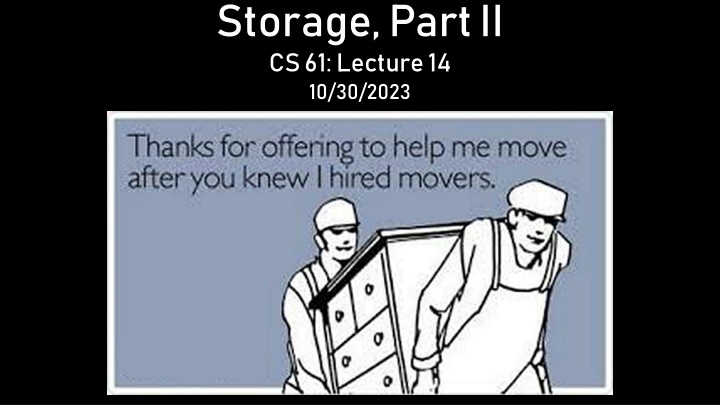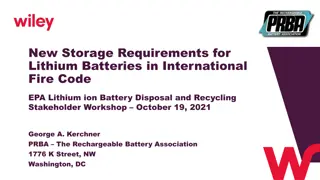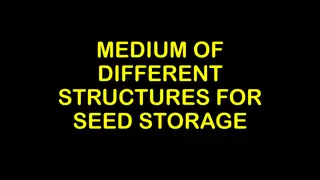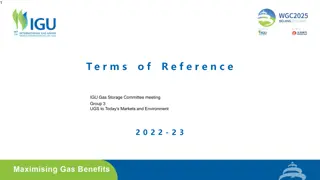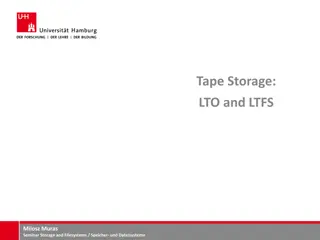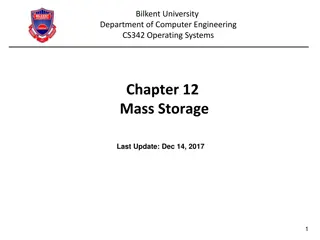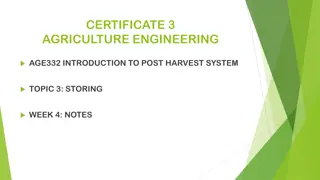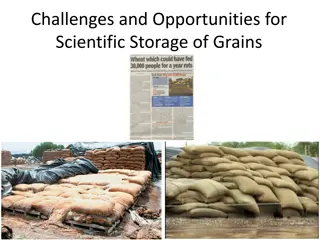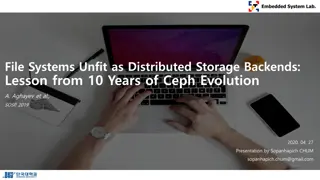Storage, Part II
- In Linux, processes interact with persistent storage devices using system calls instead of direct interaction. The kernel maintains a buffer cache in memory to store recently-accessed file blocks. The stdio library provides higher-level interfaces for file IO and implements its own caching layer. Understanding the differences in performance between functions like fputc() and write() is crucial for efficient file operations. Linux offers options for flushing buffered data and handling synchronous writes to reduce data loss risks. Explore the intricacies of file IO in Linux for optimal program performance and data integrity.
Download Presentation

Please find below an Image/Link to download the presentation.
The content on the website is provided AS IS for your information and personal use only. It may not be sold, licensed, or shared on other websites without obtaining consent from the author.If you encounter any issues during the download, it is possible that the publisher has removed the file from their server.
You are allowed to download the files provided on this website for personal or commercial use, subject to the condition that they are used lawfully. All files are the property of their respective owners.
The content on the website is provided AS IS for your information and personal use only. It may not be sold, licensed, or shared on other websites without obtaining consent from the author.
E N D
Presentation Transcript
Storage, Part II CS 61: Lecture 14 10/30/2023
Linux: C++ File IO Linux (like all commodity OSes) disallows a process from directly interacting with persistent storage devices Instead, a process must use system calls to interact with files Linux maintains a buffer cache in kernel memory The cache stores recently-accessed file blocks Linux does not synchronously flush dirty blocks to disk unless the application requests such behavior The stdio library provides higher- level interfaces for file IO Behind the scenes, the library invokes system calls The library also implements its own caching layer for file data! Application code stdio cache fwrite() stdio in libc++ write() User Kernel Buffer cache Device driver Storage device
Linux: C++ File IO We looked at two programs that iteratively wrote 1 byte of data to a file: fputc() vs. write() The fputc() version was orders of magnitude faster than a version that directly called the write() system call! fputc() is a normal function call, not a system call stdio only calls write() when the stdio-level 4 KB buffer is full, avoiding thousands of system calls (and the associated context- switching overhead)! For both programs, the kernel asynchronously flushed dirty blocks to persistent storage Asynchrony will cause data loss of non-flushed dirty blocks! Application code stdio cache fwrite() stdio in libc++ write() User Kernel Buffer cache Device driver Storage device
Linux: C++ File IO Both the Linux kernel and the stdio library allow programs to explicitly flush buffered data Flushing the stdio cache triggers a write()to the kernel s buffer cache Flushing the buffer cache forcibly sends blocks to the storage device The OS also allows a process to open() a file for synchronous write()-ing (as opposed to the kernel s default approach of asynchronous writes to the underlying storage device) Synchronous writes (and flushing in general) make a program slower but result in less data loss after a crash Application code stdio cache fwrite() stdio in libc++ write() User Kernel Buffer cache Device driver Storage device
Synchronous IO is Slower Synchronous writes: 51,200 bytes 78.665 sec 651 bytes/sec Asynchronous writes: 51,200 bytes 0.076 sec 676,034 bytes/sec You should think carefully about whether performance or crash tolerance is more important for your applications! For example, in a database, the updates in a committed transaction (e.g., involving financial data) should be persistent before clients are notified of transaction completion This ensures that the following sequence does not occur: The client receives notification that their account has received $100 The banking server crashes The banking server reboots but has no knowledge of the $100 update The client tries to spend $100 dollars that the bank doesn t think exists! //One byte per asynchronous write int fd = open( out.txt , O_WRONLY | O_CREAT | O_TRUNC); size_t size = 51200; size_t n = 0; while (n < size) { write(fd, buf, 1); n += 1; } close(fd); //One byte per synchronous write int fd = open( out.txt , O_WRONLY | O_CREAT | O_TRUNC | O_SYNC); size_t size = 51200; size_t n = 0; while (n < size) { write(fd, buf, 1); n += 1; } close(fd); O_SYNC);
Cache Optimization: Read Prefetching The basic idea is simple: proactively fetch data into the cache before it might be requested by the program If later, the data is actually requested, you ve hidden the cost of fetching the data from the slow underlying storage! If the data is not actually needed later, you ve: Generated unnecessary IO traffic, possibly delaying the storage device from handling useful requests Possibly kicked something useful out of the cache to make room for the useless data The classic prefetching optimization is for programs that sequentially read a region of the underlying storage device When the cache receives a read request for location x, the cache fetches the object at x, as well as the objects within the lookahead window For example, with a lookahead window of 3, the cache will fetch the objects at location x+1, x+2, and x+3 Linux uses prefetching in its buffer cache The kernel tries to automatically detect file access patterns which indicate that sequential prefetching would be helpful The posix_fadvise() system call also allows a process to provide the kernel with prefetching/caching hints! lookahead window
Kernel will likely perform sequential prefetch for the buffer cache! Kernel will not perform sequential prefetch Kernel will perform (possibly non-sequential) prefetch for the buffer cache!
Cache Optimization: Write Coalescing A particular cache block might be updated several times in short succession In these scenarios, the cache decreases write traffic to the underlying storage device by not immediately synching a dirty block to the underlying storage Decreasing the write traffic makes the device more available for other IO requests However, delaying the write-back of dirty data will increase the amount of data lost after a crash or power outage! read b3 write b2 write b2 //Cache flush Cache We only issued one write instead of two! Underlying storage
Cache Optimization: Write Coalescing A particular cache block might be updated several times in short succession In these scenarios, the cache decreases write traffic to the underlying storage device by not immediately synching a dirty block to the underlying storage Decreasing the write traffic makes the device more available for other IO requests However, delaying the write-back of dirty data will increase the amount of data lost after a crash or power outage! read b3 write b2 write b2 Crash! Cache Not even the first write made it to disk! Underlying storage
The Design of stdio In stdio, a FILE is mostly a wrapper for a struct _IO_FILE Each open file has a dedicated 4 KB buffer (._IO_buf_base) When a program is reading from the file: stdio uses the buffer to prefetch the 4 KB of data surrounding the target location of the read stdio fetches data on a 4 KB-aligned boundary If an fseek() takes the file position out of the current cache block, stdio does a 4 KB-aligned cache read for the new position When a program is writing to the file: stdio uses the buffer to accumulate 4 KB of data before invoking the write() system call The cache block is not aligned the 4 KB block starts at the file offset of the first write to the block At program start, the file offset for the buffer is 0 If you do an fseek(), stdio flushes the current buffer to storage; the next write will determine the new file offset for the buffer This approach: Works well for sequential reads (both forward and backwards) and forward sequential writes Works poorly for random reads and writes no system calls are eliminated! stdio s Cache struct _IO_FILE { int _fileno;//As returned //by the open() //syscall int _flags; //E.g., read-only, //read+write char* _IO_buf_base; //Other stuff . . . }; stdio stdio cache Read target Last chunk (possibly less than 4 KB) 4 KB file chunks
The Design of stdio In stdio, a FILE is mostly a wrapper for a struct _IO_FILE Each open file has a dedicated 4 KB buffer (._IO_buf_base) When a program is reading from the file: stdio uses the buffer to prefetch the 4 KB of data surrounding the target location of the read stdio fetches data on a 4 KB-aligned boundary If an fseek() takes the file position out of the current cache block, stdio does a 4 KB-aligned cache read for the new position When a program is writing to the file: stdio uses the buffer to accumulate 4 KB of data before invoking the write() system call The cache block is not aligned the 4 KB block starts at the file offset of the first write to the block At program start, the file offset for the buffer is 0 If you do an fseek(), stdio flushes the current buffer to storage; the next write will determine the new file offset for the buffer This approach: Works well for sequential reads (both forward and backwards) and forward sequential writes Works poorly for random writes (and random reads outside a cached block) no system calls are eliminated! stdio s Cache struct _IO_FILE { int _fileno;//As returned //by the open() //syscall int _flags; //E.g., read-only, //read+write char* _IO_buf_base; //Other stuff . . . }; stdio stdio cache Write target Last chunk (possibly less than 4 KB) 4 KB file chunks
Cache Coherency transparent A cache usually tries to be transparent For a read, the cache should return what a direct read from storage would return For a write sent to the cache, the newly written block should be immediately visible via subsequent reads of that block A fully transparent cache is called coherent The buffer cache is coherent with respect to the persistent storage device If a buffer cache block is clean, it represents the associated disk contents If a buffer cache block is dirty, it would be returned by a cache read for that block, and will eventually be written to the storage device What about the stdiocache? Is it coherent with the kernel s buffer cache? coherent
#define TESTFILE "consistency-test.txt" //Overwrite the contents of `TESTFILE` //with the string `contents`. void overwrite(const char* contents) { FILE* f = fopen(TESTFILE, "w"); fputs(contents, f); fclose(f); //Flushes the written //data to the kernel via //`write()`! } The stdio stdio cache is not coherent! int main() { char f1_buf[32]; char f2_buf[32]; bzero(f1_buf, sizeof(f1_buf)); bzero(f2_buf, sizeof(f2_buf));
#define TESTFILE "consistency-test.txt" FILE IN-MEM STDIO CACHE //Overwrite the contents of `TESTFILE` //with the string `contents`. void overwrite(const char* contents) { FILE* f = fopen(TESTFILE, "w"); fputs(contents, f); fclose(f); //Flushes the written //data to the kernel via //`write()`! } f1 CS 61 is awesome!\n int main() { char f1_buf[32]; char f2_buf[32]; bzero(f1_buf, sizeof(f1_buf)); bzero(f2_buf, sizeof(f2_buf)); CS 61 is awesome!\n CS 61 sucks!\n
char f2_buf[32]; bzero(f1_buf, sizeof(f1_buf)); bzero(f2_buf, sizeof(f2_buf)); FILE IN-MEM STDIO CACHE f1 CS 61 is awesome!\n overwrite("CS 61 is awesome!\n"); f2 CS 61 sucks!\n FILE* f1 = fopen(TESTFILE, "r"); fread(f1_buf, 1, 1, f1); //Induces //stdio to fetch the first 4 KB //chunk of file data, which should //start "CS 61 is awesome!\n". overwrite("CS 61 sucks!\n"); //The //on-disk version of the file //is now "CS 61 sucks!\n". //BUT!--the stdio-level cache //associated with f1 has not //changed! CS 61 sucks!\n
Non-coherent Caches Non-coherent caches exist because: They are easier to design and implement than coherent caches They are faster than coherent caches (because there is no need to track and invalidate stale data!) However, for programs that do care about coherency, life becomes more difficult with non-coherent caches Via setvbuf( ), stdio allows a process to disable stdio-level caching Applications can also flush+empty the current stdio-level cache to the kernel using fflush(FILE* fp) Why do we tolerate this witchcraft?
Linux: C++ File IO Reading/writing at a larger granularity allows the same amount of data to be handled with fewer system calls Reduces how many times you pay context-switch overhead between user code and kernel code Avoids unnecessary per-request latencies associated with the storage hardware The setvbuf()stdio call allows a process to supply a larger buffer for stdio to use for IO involving a particular file A program which directly invokes system calls can also directly provide larger buffers! Application code stdio cache fwrite() stdio in libc++ write() User Kernel Buffer cache Device driver Storage device
Larger IOs Are Your Friend The large-IO version is much Byte-per-write(): 5,120,000 bytes 6.591 sec 776,823 bytes/sec 512-bytes-per-write(): 51,200,000 bytes 0.769 sec 66,616,154 bytes/sec The OS talks to the storage device at the granularity of the device s block size The device is literally only only capable of exchanging data at that granularity! For modern SSDs and hard disks, the block size is typically 512 B or 4 KB Processes typically maximize IO efficiency by issuing an IO that is: A multiple of the block size of the underlying storage device Aligned with the device s blocks size (so that handling the IO doesn t induce any partial block reads/writes) much faster . . . //One byte per write size_t size = 5120000; size_t n = 0; while (n < size) { write(fd, buf, 1); n += 1; } //512 bytes per write (and also //write 10x the data!) size_t size = 51200000; size_t block_size = 512; size_t n = 0; while (n < size) { size_t nw = min(block_size, size - n); ssize_t r = write(fd, buf, nw); n += r; }
